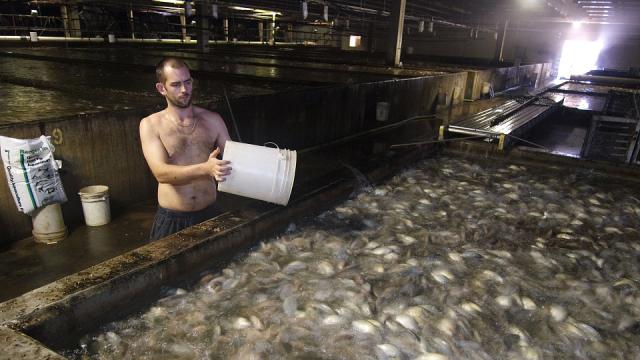The demand for seafood in America is booming, to be sure — unfortunately, the ocean’s fish stocks aren’t exactly doing the same. So how does one meet this overwhelming demand for meat? Farming fish, obviously. Lots of them.
Recirculating Aquaculture, How Does It Work?
Recirculating Aquaculture is a four-step system, starting in the grow-out tanks that house the fish population. Water is continually pumped through these tanks, introducing food and carrying away waste. Once water exits the tanks, it’s first mechanically filtered, whereby faecal matter and food particles are removed. The water is then cycled past beneficial bacterial cultures that convert the ammonia present in the water to harmless nitrogen vapour that’s released into the atmosphere. Before being pumped back into the tanks, the water undergoes oxygenation by having pure O2 pumped into the flow and any carbon dioxide removed.
The accumulated waste can then be reused — often, as an aquaponic fertiliser (which conveniently filters the water for reuse) or in methane digesters to generate electricity. There is even research underway in using the waste for bio-fuel production. By continuously filtering the fouled water and reintroducing the clean, RA systems are able to raise large amounts of fish with minimal “water footprints”. For example, BRA is able to continuously recycle about 99.75 per cent of the water flowing through its 9290sqm facility.
Having a small footprint is a boon to the burgeoning inland aquaculture industry for both fresh and salt-water species. BRA’s complex sits on just 2.5 acres of land but raises 1.8 million kilograms of tilapia protein each year — that’s between 4500kg and 9000kg a day. If they were raising cattle on the same acreage, they’d produce maybe 4500kg in the same period.
BRA, for example, raises its Tilapia from proprietary brood stock, harvesting 400,000 to 500,000 eggs every week. When the Tilapia hatch, the fry are first raised in a series of nursery tanks before being transferred to one of the facility’s 42 132,000-litre grow-out tanks with the rest of the population. Through the larval and juvenile stages, and until they’re nine months later when they weigh 0.6kg, they exist in an entirely closed system. The kicker is that each fish lives on just 5.7 litres of water apiece — that’s a lot of fish for such a small area. If you packed cattle into conditions like that, you’d have to pump them full of antibiotics and growth hormones to overcome their physiological response to the over-crowding — but not with tilapia. Packing them in like Sardines actually makes the fish less aggressive, less territorial, and even improves their growth rate. And by maintaining this closed system, the fish remain free of industrial pollutants and other nasty things — like Mercury — that’s found in wild populations.
Don’t Fence Me in
This closed system also offers significant benefits over the current offshore aquaculture “net pen” farms used to raise salt water species. Basically, their super-concentrated populations tend to release super-concentrated waste — the equivalent to dumping the raw sewage from a town of several thousand directly offshore. In addition, these fish are not only more prone to infection from their over-crowded conditions, they’re more likely to spread these afflictions to neighbouring wild species.
The Salty Smell of Success
Recirculating aquaculture was initially created specifically with fresh-water species in mind, recent advancements are showing promise in raising certain saltwater species in the same fashion. The secret is to use very low salinity water. Typical net pens have a salinity of 35 parts per thousand, however Australian RAS firms have successfully raised both Pompano and Combia (both rather expensive when raised offshore or caught from wild stock) in tanks with a salinity of only five ppt. This has obvious benefits for both the RAS industry and the environment itself — resulting in a wider selection of fish to raise while virtually eliminating the waste, disease, and nutrient runoff issues present in offshore farms. And while these systems aren’t ready for commercialisation just yet — researchers still need to tack down every aspect of the fish’s life cycle from the optimal temperature to maximise hatching to the proper amount of dissolved nitrogen necessary, to the best food to feed at each stage of life — this technique promises major benefits over current methods.
[USDA, Blue Ridge Aquaculture, Lancaster Farming, Blue Ridge Aquaculture.pdf, Wikipedia, CS Monitor]
Image: AP Images
Monster Machines is all about the most exceptional machines in the world, from massive gadgets of destruction to tiny machines of precision, and everything in between.
